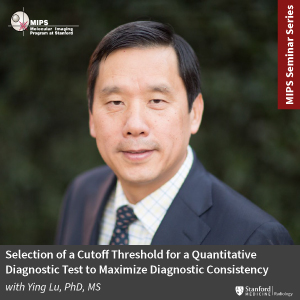
“Selection of a Cutoff Threshold for a Quantitative Diagnostic Test to Maximize Diagnostic Consistency”
Ying Lu, PhD, MS
Professor of Biomedical Data Science and, by courtesy, of Radiology (Molecular Imaging) and of Epidemiology and Population Health
Stanford University
Zoom Webinar Details
Webinar URL: https://stanford.zoom.us/s/91874119918
Dial: +1 650 724 9799 or +1 833 302 1536
Webinar ID: 918 7411 9918
Passcode: 290209
ABSTRACT
Quantitative image biomarkers are increasingly being discovered for clinical diagnoses. Receiver operating characteristic (ROC) curve is commonly used to evaluate their diagnostic performance. The performance of an ROC curve is independent of disease prevalence. When translating a biomarker to clinical applications, a cutoff threshold needs to be chosen in order to make diagnostic/clinical decisions. The choice of the cutoff value impacts the practical performance of the diagnostic test. Various methods for optimal choices of cutoff values can be found in literature. In this talk, we provide formulation for the optimal cutoff value that maximizes the kappa statistics of the diagnostic and true disease status under a known disease prevalence. We also discuss the design and sample size calculation for a validation study. Examples of applications, including the evaluation of the PTSD Checklist for the PTSD diagnosis using DSM-5 (PCL-5) and a MCG diagnostic biomarker for coronary heart disease diagnosis, are presented.
ABOUT DR. LU
Ying Lu, Ph.D., is Professor of Biomedical Data Science in the Department of Biomedical Data Science, and by courtesy in the Department of Radiology and Department of Epidemiology and Population Health, Stanford University School of Medicine. He co-directs the Stanford Center for Innovative Study Design, BERD Research Methods Core of the SPECTRUM, and the Biostatistics Core of the Stanford Cancer Institute. Before joining Stanford, he spent 15 years as a faculty in the Department of Biostatistics and Epidemiology and the Department of Radiology at the University of California, San Francisco. His research areas are biostatistics methodology and applications in clinical trials, statistical evaluation of medical diagnostic tests, radiology, osteoporosis, meta-analysis, medical decision making. He published more than 300 research papers in peer-reviewed journals, edited two books and numerous book chapters. Dr. Lu received his BS in Mathematics from Fudan University, MS in Applied Mathematics from Shanghai Jiao Tong University, and Ph.D. in Biostatistics, from the University of California, Berkeley.
Hosted by: Katherine Ferrara, PhD
Sponsored by: Molecular Imaging Program at Stanford & the Department of Radiology
